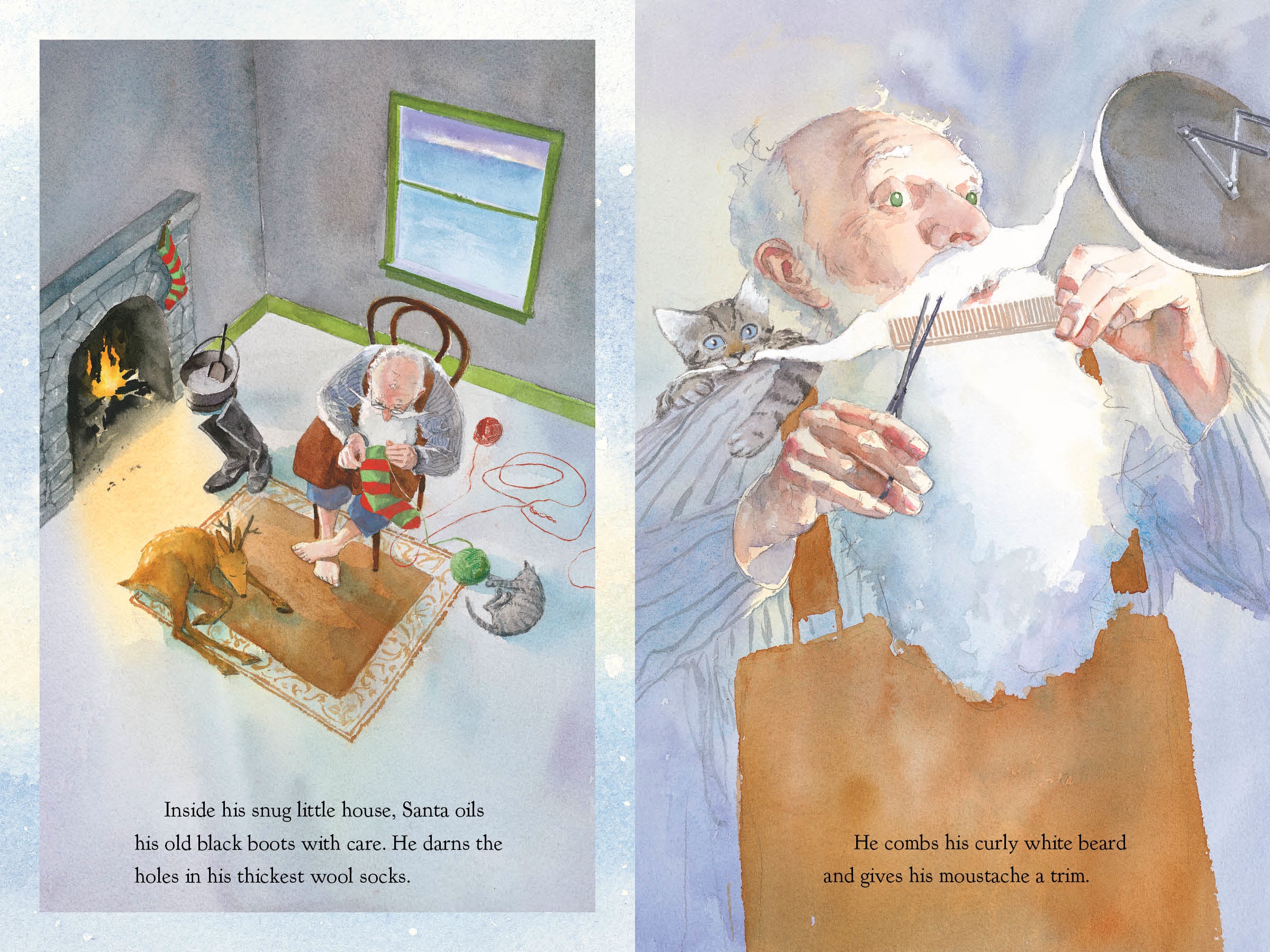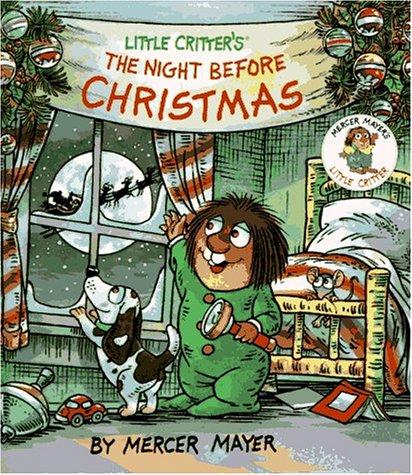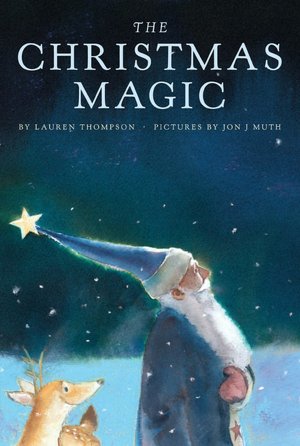The holiday books at this particular shopping-mall-bound bookstore were rather disappointing. All of the Night Before Christmases were either cartoony and bubbly or artful but all were dull in their choices: as in, she felt like she'd already looked through these books even though she hadn't. A mouse, stockings from a mantle, a man running to the window. Got it. Books that would require a lot of rationalization or cash to burn before buying.
 There were books there she recognized. She didn't bother picking up the Mercer Mayer book because she loved Little Critter books as a child. And she skimmed through The Night Before Christmas, illustrated by James Marshall, and it was also great (a chicken sleeping with the children, and all the usual and excellent detail that makes the illustrations integral to the story but also their own separate stories). But all of James Marshall's books are witty, creative, and interesting, and this one was published in 1985. She set it down, glad to be reminded of it, but still wanting to find a great recent book.
There were books there she recognized. She didn't bother picking up the Mercer Mayer book because she loved Little Critter books as a child. And she skimmed through The Night Before Christmas, illustrated by James Marshall, and it was also great (a chicken sleeping with the children, and all the usual and excellent detail that makes the illustrations integral to the story but also their own separate stories). But all of James Marshall's books are witty, creative, and interesting, and this one was published in 1985. She set it down, glad to be reminded of it, but still wanting to find a great recent book. Of all the other holiday books in the holiday section, the two she might have bought were not published this year, or even last. This doesn't suggest to her that wonderful holiday books aren't being written and published but that, for some reason, this particular bookstore wasn't going to risk stocking any of them. She has no proof of this, of course, but she did note that the book whose cover was everywhere was A Polar Express, so that must mean the money is between those covers regardless if a better story and set of illustrations is in another. Certainly, more elegant books have been made than A Polar Express.
Of all the other holiday books in the holiday section, the two she might have bought were not published this year, or even last. This doesn't suggest to her that wonderful holiday books aren't being written and published but that, for some reason, this particular bookstore wasn't going to risk stocking any of them. She has no proof of this, of course, but she did note that the book whose cover was everywhere was A Polar Express, so that must mean the money is between those covers regardless if a better story and set of illustrations is in another. Certainly, more elegant books have been made than A Polar Express.The two books that stood out were If You Take a Mouse to the Movies (2000), in terms of storyline, and The Christmas Magic (2009), in terms of illustration.
She had heard about the "Take a Mouse" books from her friend Melissa but had never read one. She can see why children like them, as the story is easy to read, fast-paced, and the mouse's insatiable cravings (at least in this story) make it a fun romp.
 The story begins with a boy taking his mouse to the movies, and his mouse wanting popcorn. The mouse then strings the popcorn, and so wants a tree, and once he has a tree, he wants. . . and so on. The mouse's desires lead to his boy becoming quite exhausted, and the reader as well--the storyline, while interesting the first time through, seems like it will not hold its sparkle forever; although, if the book is packed away each year, that may be enough to make it interesting the next year.
The story begins with a boy taking his mouse to the movies, and his mouse wanting popcorn. The mouse then strings the popcorn, and so wants a tree, and once he has a tree, he wants. . . and so on. The mouse's desires lead to his boy becoming quite exhausted, and the reader as well--the storyline, while interesting the first time through, seems like it will not hold its sparkle forever; although, if the book is packed away each year, that may be enough to make it interesting the next year. The story reminds her of Mother, Mother, I Want Another, a book her mother used to read her in which a mouse kept asking for another mother, but by the end the mouse's mother realized that the mouse didn't want "another mother" but instead wanted another kiss.
 |
Adults will enjoy If You Take a Mouse to the Movies because the mouse is much like a child with insatiable desires, and children will like the book likely because of its perceived novelty (Oh, that silly mouse!). The Tom-and-Jerry-chase quality of the story isn't new but works. It may fall a bit flat for some readers: the mouse doesn't have very interesting desires--once the mouse wants a Christmas tree, nothing the mouse chooses to do is surprising, so there surely must exist some more creative mice than the one in this book.
The ending propels the reader to imagine the whole story again and will likely cause the child reader to want to read the story again and again (or to hear the story again and again--so be forewarned, this might be a triple bedtime reading, although it's probably not the best bedtime book because it's a fast-paced romp).
This is an easy-read book good for pre-literate children, and early readers. However, the easiness of the reading and the easiness of the illustrations (not much to hold interest on that front), and its "once a year" nature make the hardback price of the book a bit prohibitive ($16.99 in store), but definitely this is one to check out from the library or search out in a used bookstore.
If You Take a Mouse to the Movies, written by Laura Numeroff and illustrated by Felicia Bond, HarperCollins Children's, 2000.
If one had only $20 to spend on a children's book this season and already had the Mercer Meyer and James Marshall books, and had The Polar Express and Raymond Briggs' The Snowman, then she would recommend The Christmas Magic. It is lucky, of course, that there are libraries since most all illustrated children's books cost nearly $20 every time.
In The Christmas Magic Santa's getting prepared to go distribute the toys. He calls the reindeer up and then goes about his house, alone, no doubt a bachelor or widower, and while perhaps "the magic" is important, he doesn't seem to care that much for it until after he's gone through his own to-do list.
The language of the story is interesting and has a clipped tonality that keeps the language from that ringy-singy "airy" rhyme that plagues much of children's literature. It's the illustrations, beautiful watercolors by Jon J. Muth, however, that make this book worthwhile and give us a Santa we don't usually see.
Muth envisions Santa as a lone figure, a bit weary, a bit lonely--a man with one stocking on the fireplace and a tall staircase full of light and a lone man climbing them. The room where Santa goes to get the toys for all the children in the world is not in a shed full of yappy elves but in a room that resembles what might have once been a nursery.
 |
| "He combs his curly white beard and gives his moustache a trim." |
It is like being able to see one's widowed grandfather going about the house, busying himself for the sake of it, able to take care of himself but the tasks do nothing to fulfill him. Certainly, it seems that "the magic" Santa is waiting for is not the same magic the children who wait for Santa are waiting for. At least, Muth asks us to consider if they are the same.
Muth combines both serious artistry and cartoon, which causes a strange but interesting dissonance for the reader. She's not sure what she thinks about that. Sometimes, she would think, Oh, why does he look like a cartoon here but not there? No doubt children will wonder the same, and no doubt some interesting conversations and thoughts will occur because of it.
The movement from the more "animated" illustrations to the more traditional and elegant illustrations just isn't as consistent and as purposeful as they could be, and it remains unclear why Muth is thinking about the story in one perspective and then in another--which is the effect. In some ways it seems as though Muth proposed two different books and the publisher couldn't decide or did decide and then rushed publication, causing Muth to include the other style paintings.
Muth may intend for readers to see the complexity of the man who is Santa by showing the more cartoony drawings, as Santa is often represented in children's books, and then placing those against the more complicated visions of Santa, in which Santa is so very human (trimming a beard that he has neglected for many months, and not because he's such a funny guy, but because he lives alone).
Regardless, she prefers the more human paintings because they suggest a skill to the artistry that the others don't, and they're more interesting to the eye, and do more for the story's depth than the others. The Christmas Magic would be an excellent choice for a bedtime read, as it is slow-paced and the illustrations are calm--allowing the eye to examine rather than being confronted. This would be an especially good early December book because it would be rather nice to get to imagine this Santa readying himself through the days.
The Christmas Magic, written by Lauren Thompson and illustrated by Jon J. Muth, Scholastic Press, 2009

